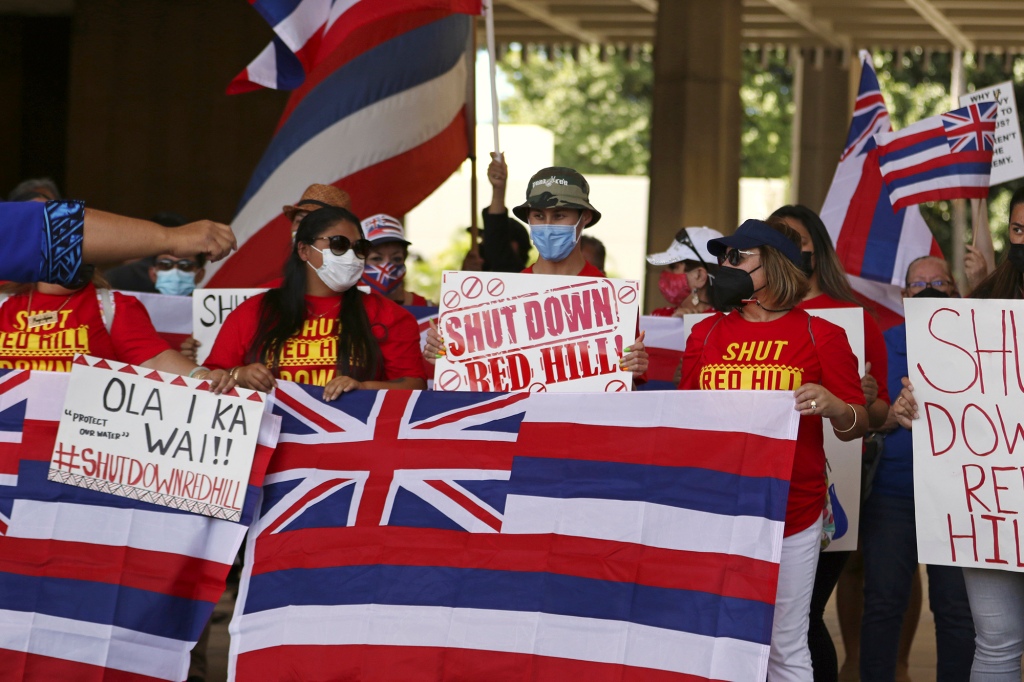Hawaii military families suffer headaches, diarrhea after drinking fuel-tainted water
A new report from the Centers for Disease Control and Prevention details the extent of Hawaii military families’ symptoms following the petroleum leak at the Red Hill Bulk Fuel Storage Facility in Hawaii.
Of those who responded to the voluntary, online survey, 87 percent reported they experienced new or worsened symptoms after the Nov. 20 fuel leak that contaminated the Joint Base Pearl Harbor-Hickam Navy water system. The system supplies water to about 9,694 Navy, Army, Air Force and civilian households. Of those who responded, 75 percent stated their symptoms lasted 30 days or longer.
“These results highlight the need for preventing exposure to petroleum products and might aid public health professionals and clinicians in detecting and responding to future similar incidents,” according to the report, compiled by the CDC and published in the May 27 Morbidity and Mortality Weekly Report.
The survey, from Jan. 7 to Feb. 10, was open to anyone in the affected area after the incident, and 88 percent of those who responded were military affiliated. At least one person in each of 1,389 households participated in the survey, which represents about 14 percent of the affected households, and a total of 2,289 people responded. Parents and guardians completed the study for children under the age of 18.
The most prevalent symptoms reported were related to the nervous system (62 percent), which included 58 percent of respondents reporting headaches. Other symptoms related to the gastrointestinal system (58 percent); skin (58 percent); ear, nose and throat (47 percent); mental health (46 percent), eyes (42 percent) and respiratory system (31 percent). Many reported more than one symptom.
Within those seven categories of symptoms there were 32 different specific symptoms. For example, the nervous system category included headaches, dizziness/lightheadedness, seizures/convulsions, fatigue, loss of consciousness/fainting, confusion, difficulty concentrating and difficulty remembering things.
Of the 1,980 who experienced new or worsened symptoms after the exposure, 80 percent reported improvement after switching to an alternative water source.
The symptoms reported in the survey “were consistent with previous studies of exposure to petroleum hydrocarbons,” the authors wrote, adding that participants’ reports that their symptoms abated after switching to another water source supported the conclusion that the health problems were exposure-related.
Of those who responded, 37 percent — 853 — said they sought medical care, including 17 who were hospitalized overnight.
A much larger number of residents actually sought medical care, based on Navy numbers. In January, Capt. Michael McGinnis, Pacific Fleet Surgeon, told lawmakers that medical providers had screened more than 5,900 patients with symptoms consistent with an acute environmental exposure event. He said those symptoms “rapidly resolved” once the patients were removed from the tainted water.


On Nov. 28, military families reported smelling fuel odors and seeing an oily film in their tap water. But some had reported mysterious abdominal pain, vomiting, memory loss, skin rashes, eye irritation, and teeth and gum issues even before the signs of fuel appeared. The Hawaii Department of Health issued a drinking water advisory on Nov. 30. The Navy and other service branches offered temporary housing in local hotels to all families affected, as an interagency team of experts developed and oversaw a massive operation to flush out the Navy water distribution system, including residences, schools, child development centers, and all other buildings.
On March 18, the final area was cleared and officials said it was safe to drink and use the water again. Residents who had left their homes returned. Officials will continue to test and monitor the water over the next two years.
Other results:
- 52 percent reported at least one sensory indication that their water was contaminated, such as petroleum smell or taste, or visible oil sheen. But a higher percentage of people exhibited symptoms, and some residents have raised questions about how long the fuel was in the water.
- 93 percent switched to an alternative water source after finding out about the fuel leak incident.
- Participants said they ingested the potentially contaminated water through oral hygiene (80 percent), drinking (72 percent) and cooking (71 percent).
In an open comment section, 53 people expressed concerns about possible long-term health effects. The report’s authors noted that the exposure levels, duration and long-term health effects are all uncertain.
“Additional follow-up of the affected population might improve understanding of the overall health impact of this and other petroleum exposure incidents,” the authors wrote.
Defense officials have established an incident registry to include all the individuals that may have been exposed to this contaminated water event.
“This incident report will be available for future action, research or analysis to ensure we track the long-term health of those potentially exposed,” said Surgeon General of the Navy Rear Adm. Bruce Gillingham in written testimony to the House Appropriations defense subcommittee on May 25.
Read the full article Here


